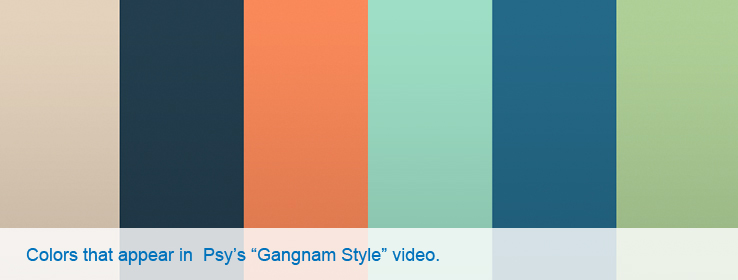By Kim Palmer
What makes a video go viral? A catchy tune sure helps, but colorful visuals also play a very important role.
"Gangnam Style" ― if you haven't heard it, you've probably at least heard of it. The wildly popular song by South Korean rapper Psy took the globe by storm. Its colorful
YouTube videowas the first to reach 1 billion views worldwide and remains the most-watched video of all time, with 1.7 billion views as of July 2013.
You might think a rap video, however successful, has nothing to do with interior design. Aidan Huang, editor-in-chief of the design blog
One Xtra Pixel (OXP), disagrees.
"Anything that becomes so popular that it attains viral status can and should be dissected in order to determine what it is that made it so popular," Huang wrote in a recent post
What Designers Can Learn From Gangnam Style.We caught up with the Singapore-based Huang to talk about global humor, today's biggest style influences and why he decided to write a piece targeted to designers.
"I feel designers and singers or celebrities are all artists. While we enjoy the video, we can dig deeper into what we can learn from the video and apply it to different professions ― even interior design," Huang says.
What made the video go viral? Huang sees three key ingredients:
Humor:
"Gangnam Style" features absurd costumes, silly scenes and the rapper's signature goofy "horse-riding dance." "Everyone loves fun," Huang says. "The fact that it makes people laugh is enough to make them want to pass it on and share it with their friends."
Design, too, should be fun and not take itself too seriously, according to Huang. "It's OK to include humorous aspects in your designs. People like to be amused, and gaining a reputation as a funny, personable individual can be very beneficial to you as a business person. But be sure to understand the nature of your client and take their business seriously."
Sex:
The video's refrain, "Hey, sexy ladies!" is illustrated by an array of attractive young women dancing and demonstrating yoga poses in stylish, skimpy outfits. Using sex as a marketing tool is nothing new, Huang notes, but sexuality and sexual humor remain powerfully effective, especially when marketing to a younger demographic. "The video manages to allow the women to exude sexuality without being objectified, which makes their presence palatable to a wider range of viewers," Huang says. "The key is moderation" ― a sexy vibe without using nudity or overt sexuality, so viewers use their imaginations.
Design:
The sets in "Gangnam Style" feature bright, high-contrast shades of cheerful colors and sleek shiny exteriors of chrome, glass, metal and plastic, Huang says. "People are naturally more attracted to color and design schemes that are clean and not excessively complex. Sleek, uncomplicated design is key to creating a look that is intuitive to the user and appealing to all demographics."
That sleek, modern aesthetic may have special resonance because of one powerful style influence: "I don't have data to prove this," Huang says, "but I believe the trend of sleek, shiny sets is more appealing today. It could possibly have been ignited by the design of Apple products."
Huang also noted the video’s distinctive use of color. Many scenes feature striking monochromatic color schemes, such as when Psy and two women, dressed in white, are covered with a gust of white paper snowflakes. Other scenes feature dichromatic or simple complementary color schemes, such as when Psy, wearing a bright blue suit, appears in a dance face-off with comedian Yoo Jae-suk, wearing a bright yellow suit.
Psy's latest video, "
Gentleman," also went viral when it was released this spring. The rapper used many of the same ingredients ― humor, beautiful performers and sleek modern design ― in this video, too. But this time, Psy toned down the color. Instead of candy-colored sets and costumes, the palette for "Gentleman" is more neutral. And, befitting the video's title, the rapper himself has (mostly) traded his Easter egg wardrobe for classic black and white.





